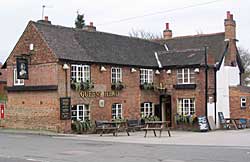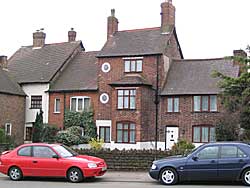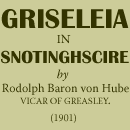< Previous | Contents | Next >

Queen's Head pub at Watnall (Photo: A Nicholson, 2004).
In the 26th year of Edward III. when the aid of 40 shillings for every Knight’s fee was required, to make the King’s eldest son a Knight, Wm. de Amyas was found to hold the fourth part of a Knight’s fee in Watnowe, which Richard de Kimmerley had held in former times.
The Borough Records of Sept. 25th, 1397 throw a sidelight on one of the religious ways of that time, i.e.:
Richard de Watnowe, Chaplain, by his attorney John Breadsall, complainant, appeared against Nicholas Barnack and against Margery his wife in a plea of debt, that the said Nicholas owes him six shillings and eightpence for an indulgence obtained for them by Master Thomas de Kirkby, in the year of grace of our Lord, 1391, at Rome, &c. The Watnall Chaplain lost his suit, but it shews nevertheless that papal indulgences were a familiar matter in those days.
In the 20th year of Henry VI., John Wollaton of Nottingham, cousin and heir of William Arnyas, remised to John Viscount Beaumont and others, all his right in the manor of Watnall Chaworth, which was late William Wollaton’s, his brothers; and the Close Rolls of the same year shew that William de Wollaton had pardoned the Prior and convent of Bevall for acquiring from the Vicar of Greasley (who must have been Robert Felowe, who was instituted in 1501, and died at Greasley), without his consent, 1 messuage and 1bovat in Watnall Chaworth, which had been Hugh de Cressy’s; 8 acres of land which was Richard Selston’s in the same town, and 5 tofts and 13 acres of land in Brokebresting, which was sometimes John de Pynkestone’s and others, and which was held of him and John Skeffelin of Broxtow, &c.

Row of distinctive cottages at Watnall (Photo: A Nicholson, 2004).
The next name of importance (to us in special) is that of Richard Bingham mentioned in Thoroton. He and Ann his wife, in the 7th year of Henry VIII., suffered a recovery of a moiety of the manor of Riddinges. This Richard Bingham is the last link between the past and the present. This Richard Bingham was of Watnall Chaworth, and Thoroton writes that he married Ann, one of the 4 sisters and heirs of Nicholas Strelly of Lindsby (Throsby V. 2, 243). There is a mistake or a discrepancy in that. Either Richard, who married Ann Strelley, had lost a first wife, or he must have been the son of another Richard Bingham who married a Colston of Car Colston. One reason for this observation is, that there is a recovered brass shield of arms, unfortunately obliterated, hut with it a brass label, in Greasley Church, recording the resting place of Helena, wife of Richard Bingham. Either this Helena was the wife of Richard whose son married Ann Strelly, or Thoroton was misled in giving Ann, instead of Helena, as one of Nicholas de Strelly’s heirs, which from public documents cannot be.
The Binghams were a family of distinction whose origin we may briefly trace. The township of Bingham was by the Conqueror given to the famous land-absorbing Roger de Boullie, and passed from him to William Pagenel and others in succession, until it was by Henry III. given to Ralph Bugge, of whom the Binghams, who took their name from the place, are descended. We have met with them for the first time in about 1284. After only 4 or 5 generations in their descent, their property came into the hands of Sir Thomas Rempton; but among the branches of the family which survived, one settled at Car Colston. from whom Richard Bingham of Watnall Chaworth descended. He left two daughters, of whom Ann married Rafe Purefey of Drayton; and Margaret became the wife of Ralph Rolleston, from whom the present owner of the Watnall Hall estate is a lineal descendant. The family is a long-known one of honoured repute. The first Rolleston we read of was of Rolleston in the County of Stafford, who bestowed much succour to the unfortunate around him, and built some almshouses at Rolleston, which he also endowed.
In the reign of Henry II. Thomas de Rolleston is met with as a witness to a Deed by Richard de Houten to Walter de Mores. In 1410 Robert de Rolleston was one of the Prebends of the Collegiate Church of Southwell, the now Cathedral of our Diocese. Again, a John de Rolleston was at one time Chief Lord of the fee of Stoke.
Henry Rolleston was one of the witnesses to an agreement between the Abbot and Convent of Welbeclc and Robert de Sommerville of Oxton, Hugo de Capella, and Walter de Straitley.
In about 1645 a Rolleston married Ger. Franc., daughter of Robert de Pierpoint and Gertrude his wife, daughter of Henry Talbot.
And in the reign of James I. Lancelot Rolleston, with Gervas Wyld, Christopher Strelley and John Wood, who was one of the Verderers of Sherwood Forest, petitioned the King to have their right of a Fee Tree and a Fee Deer (which had been withheld) restored to them.
But all the above are fragmentary and discoursive notes which we made from widely scattered readings in one work and another, until we come to Malgern de Rolleston, who was a benefactor to the Monastery of Rufford, on which he bestowed 40 acres of land. Thomas, son of Malger, held two knight’s fees of Walter d’Aincourt. Henry, son of Thomas de Rolleston confirmed to the Monastery of Rufford all that his grandfather Malger had given to it. Thomas, son of Henry, and Benedict, son of Thomas de Rolleston, in like manner confirmed to Rufford Malger de Rolleston’s gift. Benedict de Rolleston was a Knight, who gave and confirmed to the Church of St. Peter at Thurgarton, &c., several lands (at that time in the tenure of several persons) so absolutely that neither he nor any of his heirs might subsequently be able to challenge any aid of the said tenants, natives or villains, whether to make his eldest son a Knight, or to marry his eldest daughter; and the Lady Dimysia, wife of Benedict de Rolleston, released her dower in the same lands.
There is also a branch of the Rolleston family in Derbyshire, and one in Ireland, beside those of Staffordshire, from whom the present Squire of Watnall is descended; and it is with regard to a member of the Derbyshire family that we propose to give the results of an interesting investigation.
In Queen Elizabeth’s reign the unfortunate Mary, Queen of Scotland, during her imprisonment, reckoned a Rolleston among her attached and faithful well-wishers, whom she also honoured with entrusting him (as some writers say) with her cypher. We believe, however, that the so-called cypher was (as we have somewhere read) a jewel in the shape of a royal seal, bearing M.R. for Maria Regina on the sides of the crowned shield of arms, of which we have an impression—on wax. The seal was in the possession of a late lady of the Rolleston family, and may still be among their private treasures.
